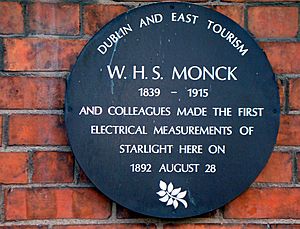William Henry Stanley Monck facts for kids
William Henry Stanley Monck (born April 21, 1839 – died June 24, 1915) was an Irish expert in stars and planets, also known as an astronomer, and a deep thinker, or philosopher. He studied at Trinity College Dublin. In 1878, he became a professor of moral philosophy, a job he held until 1892. On August 28, 1892, he made history by being the first person to measure starlight using electricity! For many years, Monck also worked as a Chief Registrar for the High Court of Ireland. He wrote many books and articles about logic, metaphysics (the study of what is real), and astronomy. He was also one of the people who helped start the British Astronomical Association.
Contents
Early Life and Family Background
William Henry Stanley Monck was born on April 21, 1839, in a place called Skeirke in County Laois. When he was young, teachers came to his home to help him learn. Later, he moved to Dublin and went to Trinity College Dublin. He was very good at his studies, even coming first in a big science exam in 1861.
He married Kate Winifred Stanley Monck. They lived in Dublin with their servants. William and Kate were Protestants, and they did not have any children.
The Monck family was quite old and important in Ireland. They were known as Anglo-Irish Protestants. It's believed that William was related to Lord Monck, who was important in bringing Charles II back as King of England in 1660.
Monck's Amazing Career
Monck started his career as a professor of moral philosophy at Trinity College Dublin. Here, he wrote books like "An Introduction to Kant's Philosophy" and "Introduction to Logic," which helped people understand complex ideas.
In 1875, he became a lawyer. After that, he worked as the Chief Registrar in the Bankruptcy Division of the High Court of Ireland for many years. This was a very important job.
Measuring Starlight with Electricity
In 1892, Monck, along with George F. Fitzgerald and S.M. Dixon, did something amazing. They were the first to measure starlight using electricity! They used special devices called photovoltaic cells, which were made by George M. Minchin. These measurements were taken from a telescope in Monck's own backyard. To remember this important event, a special plaque was put up at 16 Earlsfort Terrace in Dublin on April 6, 1987.
His Ideas About Stars
Monck was very well known for his new ideas about astronomy. He wrote many letters to The Observatory magazine. These letters often talked about how the Sun keeps its heat, and about old eclipses and how we measure time. He also wrote for The English Mechanic and other newspapers.
One of Monck's most important ideas was that there were two different kinds of yellow stars. He thought some were dim and close, while others were bright and far away. Another astronomer, J. Gore, later developed this idea further.
Monck also noticed a link between how stars move across the sky (their proper motion) and their types (spectral types). He wrote about this in Astronomy and Astrophysics. He showed that younger types of stars move slower than older types.
Because of his important work, Monck became a member of the Astronomical and Physical Society of Toronto on October 4, 1898.
Later Life and Legacy
Monck stopped working at Trinity College Dublin in 1882. In 1890, he wrote a letter suggesting that amateur astronomers should have their own group. At the time, the Royal Astronomical Society didn't let women join, and it was mostly for very important people. Monck's letter helped create the British Astronomical Association in October 1890, and he was part of its first leadership team.
Towards the end of his life, Monck became more private. But he never stopped being interested in learning. He spent most of his time at home in Sligo, reading books about philosophy and astrology. People said he also enjoyed playing chess.
William Henry Stanley Monck passed away on June 24, 1915. His wife died a few months later. They are buried together at St. Michael's, Clonoe, in County Tyrone. Their tombstone has the words "peace perfect peace" written on it.
Monck's Lasting Impact
Trinity College Dublin has honored Monck's achievements by opening the WHS Monck Observatory. This observatory is on top of the Fitzgerald building and has a 10-foot Fiberglass dome. It also has a special platform to stop vibrations from people's footsteps from affecting the telescope inside. It officially opened on December 12, 2008.
Monck's work helped us understand more about stars and how to measure them. His ideas and contributions continue to be remembered in the world of astronomy.
Images for kids



